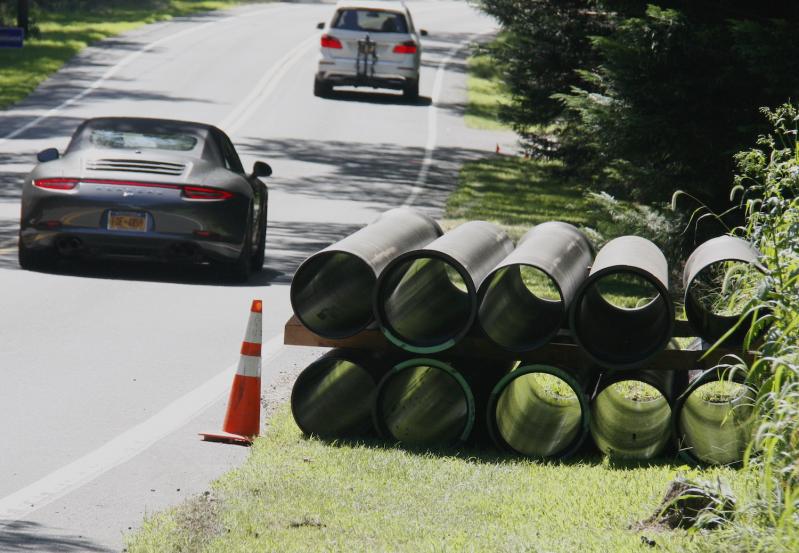In the wake of the federal government’s announcement last week that utilities will be required to reduce levels of toxic “forever chemicals” in drinking water to almost zero, residents of Wainscott are using that news to press opposition to both the South Fork Wind farm and the proposed Wainscott Commercial Center.
The Biden-Harris Administration proposed the first national drinking water standard for six perfluoroalkyl and polyfluoroalkyl substances, of a class of chemicals known as PFAS, as they have been determined to be dangerous at any level of exposure. The federal Environmental Protection Agency will propose legally enforceable levels for the substances known to occur in drinking water.
If finalized, the E.P.A.’s proposal will regulate perfluorooctane sulfonate, or PFOS, and perfluorooctanoic acid, or PFOA, as individual contaminants, and the other four as a mixture. The proposal is to regulate PFOS and PFOA at a maximum of 4 parts per trillion. Its previous recommendation was that drinking water contain no more than 70 parts per trillion.
In 2017, Suffolk County Health Department officials discovered PFOS and PFOA, at levels in excess of the E.P.A.’s acceptable levels for lifetime exposure, in private wells in the area of East Hampton Town Airport in Wainscott. The suspected source is aqueous film-forming foam that was used and stored at the airport in the form of firefighting foam. Forty-seven of the airport’s 570 acres were added to the New York State Department of Environmental Conservation’s Registry of Inactive Hazardous Waste Disposal sites, or Superfund sites.
The discovery led to an expanded area in which wells were tested for the perfluorinated chemicals, the provision of bottled water to affected residents in the short term, and an offer of rebates for installation of point-of-entry water treatment systems to those whose wells were found to be contaminated. The town created a water supply district encompassing almost 900 properties, which allowed the Suffolk Water Authority to extend water mains to residences that relied on wells that could have been contaminated. Approximately 45,000 feet of water main was added in the hamlet in 2018.
But concern about PFAS, which can cause serious health problems including cancer and liver and thyroid damage, and may negatively impact fetuses, breastfed infants, and immune systems, remains high in the hamlet. Opponents of the wind farm, who have cited downsides from higher utility bills to the danger posed to whales by its construction, issued a statement the day after the Biden administration’s announcement.
Citizens for the Preservation of Wainscott, a group formed to oppose the wind farm and which attempted to force a vote to form an incorporated village in order to prevent the wind farm’s export cable from making landfall in the hamlet, said that its lawsuit against the federal Army Corps of Engineers revealed that the Corps “failed to take the required ‘hard look’ at the serious public health and safety concerns” related to PFAS contamination. Members of the group have complained that onshore construction — the export cable’s burial from its Beach Lane landfall to an electrical substation in East Hampton, and construction and installation of several underground vaults — posed a threat to public health given the existence of PFAS there.
Of around 1,200 emails revealed in its lawsuit, none show that PFAS concerns were raised by the Corps prior to federal approval of the project, the group asserts. “After months of government stonewalling and only through a lawsuit, we now know that the Army Corps of Engineers ignored their legal obligations to properly consider the effects of contaminated groundwater on the health and well-being of the citizens of Wainscott,” Gouri Edlich, chairwoman of the group, said in a March 15 statement. “An alternative viable route for South Fork’s onshore cable landing was identified by federal officials — a route that would have steered well clear of a residential neighborhood, a state Superfund site, and any PFAS risk to the public,” she said of a proposed landing site at state-owned land in Montauk, “but the rush to be first with offshore wind projects apparently superseded concerns for citizens’ well-being.”
The proposed Wainscott Commercial Center, where a plan to divide 70.4 acres of a former sand mine into 50 commercial parcels has been received unfavorably by many residents and town and county officials, has also been cited as a hazard with respect to PFAS. In a letter to residents, Simon Kinsella of Wainscott, who is also a vehement critic of the wind farm, said that he was disappointed that the Planning Board had deemed the proposed commercial center’s draft environmental impact statement complete “without a remediation plan to remove existing PFAS contamination,” which he said equals or exceeds PFAS levels at the airport. “Like the airport site, unless the contamination is removed, it will continue to contaminate the sole-source aquifer, drinking water supply wells downgradient, and Georgica Pond.”
The draft environmental impact statement, he wrote separately to Sam Kramer, chairman of the Planning Board, “contains neither a remediation plan for PFAS soil contamination that will continue to adversely impact the town’s drinking water supply nor an alternative analysis as required by” the State Environmental Quality Review Act. Rather, he wrote, it relies “solely on an outdated and unsubstantiated conclusion” by the D.E.C.




